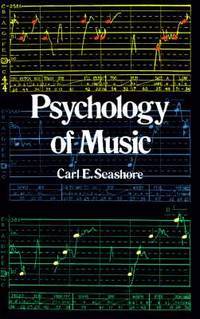
The Psychology of Music Soft cover - 1968
by Seashore, Carl E
- Used
- Good
- Paperback
Between the physical world of vibration and the world of consciously heard music lies a third area, which is the province of the psychology of music. This introduction, first published in 1938, by the developer of the Seashore test of musical ability, is a thorough survey of this field. A standard text for psychologists specializing in the area, teachers, or interested musicologists.
Description
Standard delivery: 14 to 21 days
Details
- Title The Psychology of Music
- Author Seashore, Carl E
- Binding Soft cover
- Edition Dover reprint ed
- Condition Used - Good
- Pages 448
- Volumes 1
- Language ENG
- Publisher Dover Publications Inc, New York
- Date 1968
- Bookseller's Inventory # 079816
- ISBN 9780486218519 / 0486218511
- Weight 1.2 lbs (0.54 kg)
- Dimensions 8.4 x 5.4 x 1.2 in (21.34 x 13.72 x 3.05 cm)
- Library of Congress subjects Music - Psychological aspects
- Library of Congress Catalog Number 67027877
- Dewey Decimal Code 781.15
About Seagull Books East Sussex, United Kingdom
Originally started as an amateur venture, Seagull Books has quickly grown into a knowledgable and reputable on-line book vendor. Our inventory is growing all the time, and we are constantly updating our stock with the latest finds. We specialise in out-of-print books - particularly paperbacks - and never cease to be amazed at what is no longer considered worth publishing! Many of our customers clearly share that view.
All orders will be dispatched within 1 working day of purchase, and often on the same day. If a book does not meet a customer\'s expectations, then a full refund, including outgoing P&P, will be offered upon return of the item. Refunds for any other reason will be processed minus the outgoing P&P. The quality descriptions we use match those that are found on Amazon e.g. Like New, Very Good, Good and Acceptable. In most cases, we have also added more detailed comments ourselves about the condition of a particular book.
From the rear cover
Between the physical world of vibration, as measured by apparatus, and the world of consciously heard music there is a third area of investigation. Our auditory apparatus and/or mind separates different instruments and tones, hears some vibrations but not others, adds tones to fill out the sound spectrum, etc. This middle ground is the province of the psychology of music, a subject about which even many physical scientists know little.
This introduction, by the developer of the Seashore test of musical ability, is a thorough survey of this field, the standard book for psychologists specializing in the area, for the school, and for interested musicologists. It opens with the musical mind and with a series of chapters on music as a medium: vibrato, pitch, loudness, duration, timbre, tone, consonance, volume, and rhythm, dealing with each from the special point of view of the role of psychology. It then moves to such factors as learning, imagining, and thinking in music; the nature of musical feeling; the relative sound patterns of specific instruments and the human voice; measures of musical talent; inheritance of musical ability; primitive music; the development of musical skills; and musical aesthetics.
This wealth of material is supplemented with dozens of oscillograms and other sound-pattern charts recorded from actual play and singing by Jeritza, Caruso, Paderewski, Szigeti, Rethberg, Menuhin, Martinelli, and other artists. An appendix cites two attitudes toward the evaluation of musical talent and over 200 bibliographic references.
